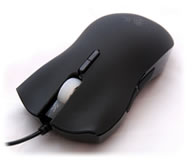Final Thoughts
Each of the mice we looked at today offer a unique blend of features, specifications and overall styling queues. Starting with the Logitech bunch, I really liked the inclusion of the tilt wheel, a feature that is exclusive to the G5 and G9. Both of these mice also used a nice looking braided cable instead of the standard plastic coating - perhaps not a huge selling point, but little details like this really stand out in my mind.
The G5 lost some points in my book due to its overly difficult-to-depress scroll wheel button. The Logitech mice were also the smallest mice of the round-up, which may or may not be such a bad thing for you.
Considering we first reviewed the G5 back in January 2006, it should be safe to say that this model has endured the test of time, with this second revision fixing the #1 bugging issue of the original that only carried a single thumb button.
Microsoft's offerings, the SideWinder and the Habu, were on opposite ends of the spectrum. The SideWinder just didn't cut it for me. While I really liked some of its unique features, namely the interchangeable mouse feet and the LCD display, it was way too large for my hand. The side thumb buttons also felt very strange - I much prefer the standard horizontal layout. All of this, and the fact that the SideWinder just didn't feel as "solid" as the other mice left me wanting more.
The Habu, on the other hand, was an absolute pleasure to work with. The mouse felt great under my hand, even after hours of gaming and general use in Windows. The blue LED lighting looked really nice and was not overly bright. Interchangeable thumb buttons means you can have two different layout options for the best possible fit and feel. The only issue I had with the Habu was the fact that you are required to update the firmware if you want to use the on-board profile memory feature.
When the Habu was first released, it got very positive reviews but was criticized for its expensive price. Now the Habu sits next to the G5 as the less expensive choices within this round-up.
Moving on, with nine programmable buttons and a 4000 DPI laser, the Razer Lachesis was clearly designed with hardcore gaming in mind. This is the only product that caters to both left and right hand users, in fact, most Razer products usually do.
This could be a huge selling point if you are a leftie, but honestly I have never seen someone use a mouse with their left hand. Due to this design, the mouse was not too comfortable over longer periods. I also experienced some problems with tracking, specifically if I put too much weight on one side of the mouse with my hand, causing the mouse to lean slightly. Other than this, the Lachesis worked very well and if you have experimented before with Razer mice, chances are you won't have the same kind of problem.
At the end of the day, any of these products will certainly improve your gaming experience over any standard two-button scroll optical mouse. However, my personal choice has to be the Microsoft Habu, which offers a nice blend of everything I look for in a gaming mouse, including lasting comfort for those long gaming sessions. Unfortunately it's impossible for us to dictate what will work the best for you, but we are sure that by now you will have made up your mind on how much you want to spend, and what kind of features and design cues from this selection of premium devices appeal the most to you.
